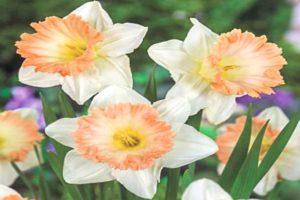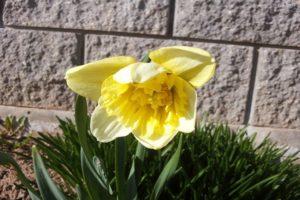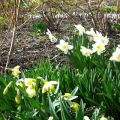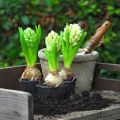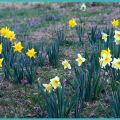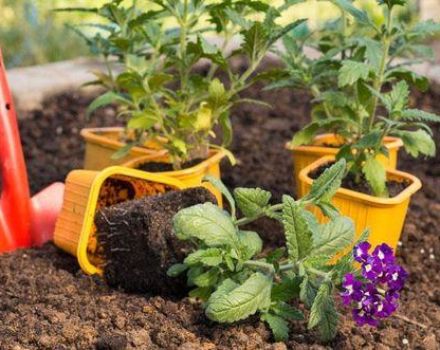Description of the daffodil variety Sir Winston Churchill, planting and care rules
Daffodils are considered attractive flowers and come in a variety of varieties. The flowering period occurs in early spring, when other plants are just beginning to awaken. Having planted a terry daffodil variety Sir Winston Churchill in the garden, you can admire it for many years.
Description and features of the variety
Narcissus Sir Winston Churchill was first recorded in 1946. The homeland of this variety is the Netherlands. Speelman and Sons is considered the originator. In 1998, the Royal Horticultural Society awarded the flower a prestigious award. The plant belongs to the "Terry" class.
Flowering begins in early April and lasts about a month. This variety is distinguished by creamy white petals with an orange tint, a red heart with aster-shaped flowers and a double split crown.
Peduncles grow up to 40-65 cm. The diameter of the flowers is large - up to 6 cm. The flowers are rounded, with additional petals and a double tube. 4 flowers are formed on each stem. The leaves are blue-green, straight.
The flower conquered the hearts of florists with its pleasant and delicate aroma, extraordinary and bright appearance. The plant will decorate any flower bed or border, will perfectly fit into any landscape design. Cut flowers retain their freshness for a long time.

Breeding history Sir Winston Churchill
In 1922 Winston Churchill acquired a small estate in Chartwell. The castle was distinguished by its excellent location and beautiful scenery. The main advantage of the estate was a picturesque garden. Churchill's wife chose the flowers for the garden.
Among the many plants in the garden were peonies, lilies, fuchsias, mint catnip, panstemones, azaleas, and daffodils. The garden was also amazing for its home for butterflies, which Winston was fond of. According to one version, it was because of this hobby that the variety of daffodils was named after the politician. Daffodils are loved not only by people, but also by bees and butterflies due to their bright colors and pleasant aroma.
Growing
It is possible to stretch the flowering period of daffodils in open soil not only with the help of early and late varieties, but also by the way of regulating their flowering by planting dates. The main condition for a good harvest is the selection of a comfortable site. Daffodils prefer shaded lawns with drained, slightly alkaline and nutritious soil. The plant should be transplanted to another place after 5-7 years.
Landing dates
Planting time depends on the climatic season. You can plant bulbs in open soil from mid-August to early November.It is undesirable to plant flowers after the end of October - the bulbs will not accept well or freeze. The flowering of plants of the same variety, planted in the middle of the specified period, will last from 10 to 15 days. Having planted the bulbs earlier, you can admire their flowering for a whole month.
Soil preparation
The soil should be pre-drained and dug up. Digging depth should be 30-35 cm. If the soil is heavy clay, you need to fertilize it with sand, peat, light soil is fertilized with turf or humus. It is best to prepare the soil in early June. Bulbs should be stored in a cool, draft-free room at 18-20aboutC. Before planting, they should be dusted with TMTD (tetramethylthiuram disulfide).

Landing scheme
The pits should be made standard, 10-15 cm deep.In heavy soil, plant smaller, with light pits, tear out 20-23 cm deep.The bulbs should be 10 cm apart.Rows are made at a distance of 25-30 cm.After two weeks the upper layers of the soil must be leveled and sprinkled with leaves.
Care rules
Daffodils do not require scrupulous care, but in order for them to please with their flowering for many years, you need to provide them with the necessary conditions.
Loosening and weeding
In March, the insulation is removed from the flowers. Further, they need systematic loosening, weeding, feeding and watering. The soil is loosened after each watering, rain or top dressing, weeded and weeds are removed.

Watering
For better growth, it is important to maintain sufficient soil moisture. After flowering, the plant needs abundant watering. Rhizomes should be poured completely, 1.5-2 buckets of water per 1 m2.
Protection from pests and diseases
Narcissus Sir Winston Churchill often suffers from fusarium disease, sclerocial rot and viral diseases. The following pests should be distinguished:
- root nematode;
- stem and bulbous nematode;
- large daffodil fly;
- small onion fly.
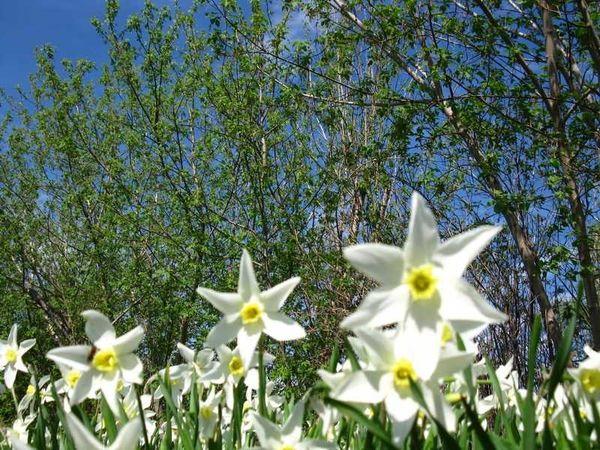
Before the flowering period, preventive measures should be taken against fungal infections using chemical fungicides. The fungus can be recognized by spotting, bloom or rot. With a viral lesion, heterogeneous spots and striations appear. Antiviral drugs are used for treatment.
Daffodils suffer from beetles, ticks, larvae, beetles, bears and wireworms, which feed on stems, bulbs, buds and leaves. Chemical insecticides help control pests.
Preparing for winter
After planting a flower in mid-September, you should cover it with a layer of dry leaves in a layer of 10 cm. Late planting prevents the bulbs from taking root and reduces the chances of their survival at low temperatures.

Top dressing
The growth and development of the bulbs will be provided by feeding with nitrogen and potassium. At the beginning of the growing season, when the leaves germinate, nitrogen fertilizers will be required. When peduncles appear, potash preparations are needed. The third feeding should be done when the bud appears with complex fertilizers. The last time the plants are fed during flowering with phosphorus-potassium elements.
Reproduction
There are several ways to breed:
- vegetative - with the help of bulbs and children;
- freshly harvested wet seeds in the summer-autumn period.
The seeds are sown in a pot, box, or open soil. It is necessary to plant shallowly, with a depth of 20-25 cm. For the first few years, the seeds cannot be reached to form a good, strong bulb. In the third year, the plant can be transplanted to another site. The flowering of these daffodils will be after 5-6 years, in small-flowered varieties - in 2-3 years.

Application in landscape design
Daffodils decorate the lawn, multi-colored beds, mixed flower beds, borders or rockeries. This composition looks very impressive, bright and unusual. There are three ways to plant a plant on your lawn:
- cut out a piece of turf, plant a group of bulbs;
- scatter the bulbs on the lawn, remove the sod under them and bury them.
The second method allows for a more natural and picturesque lawn. Daffodils of the Small-crown variety are best suited for such a planting. Plants of Terry, Large Crowned and Tacetous varieties are unsuitable.
Curtains are considered one of the popular design solutions. These are large flower beds planted near decorative structures or along a path. In addition to daffodils, curtains combine various flowers like hyacinths, daisies, forget-me-nots, tulips, crocuses and pansies.
Reviews
Sir Winston Churchill, a daffodil variety, has garnered a lot of positive reviews from experienced florists.
Alena, 30 years old.
I love this variety, its flowers are slightly smaller than those of single ones, but they look just lovely on the lawn. I have 18 varieties, but this one is admired by me and my household. I like terry petals and good breeding ability.
Christina, 40 years old.
Recently I began to get carried away with flowers, I decided to plant daffodils. I liked the variety Winston Churchill, chose because of its bright unusual colors. I planted it, I will wait for flowering.
Lyudmila, 54 years old.
I ordered my mother for the beds, she loves such cute flowers. We were imprisoned with her, now we are waiting for the results.
